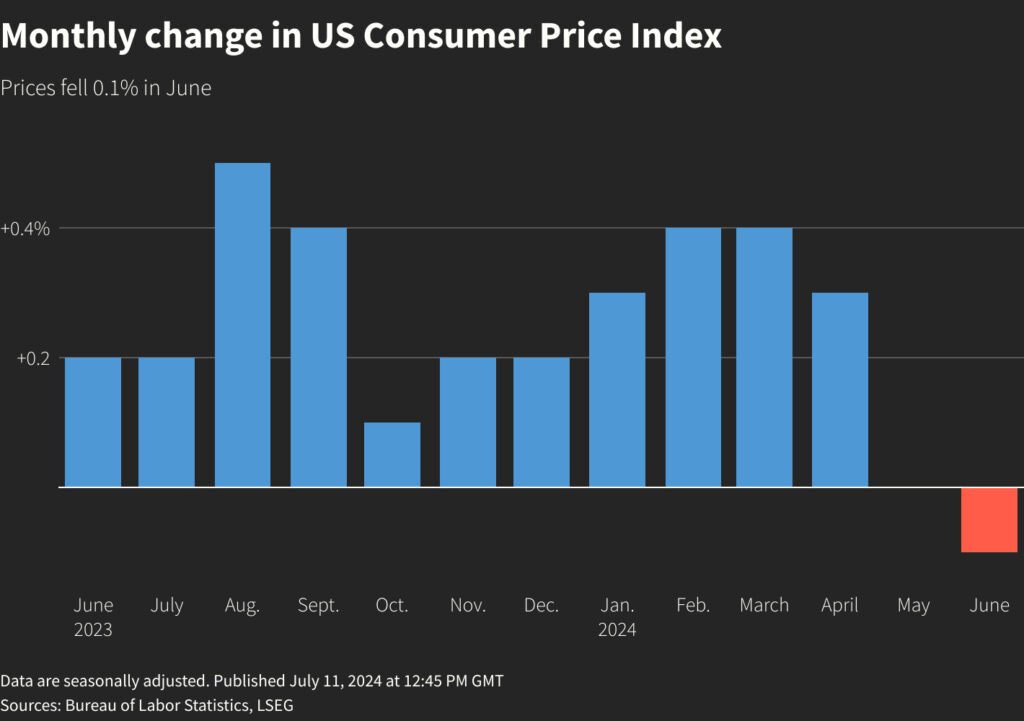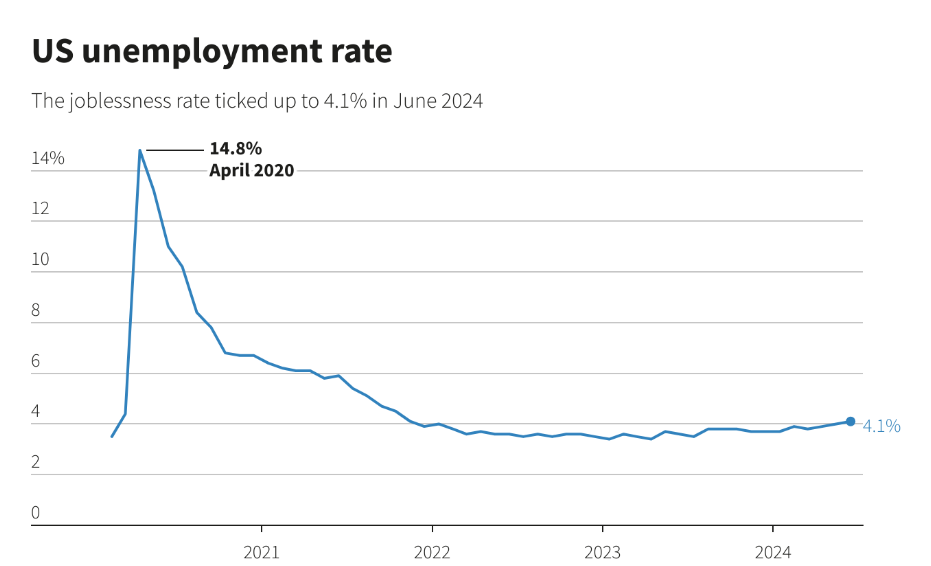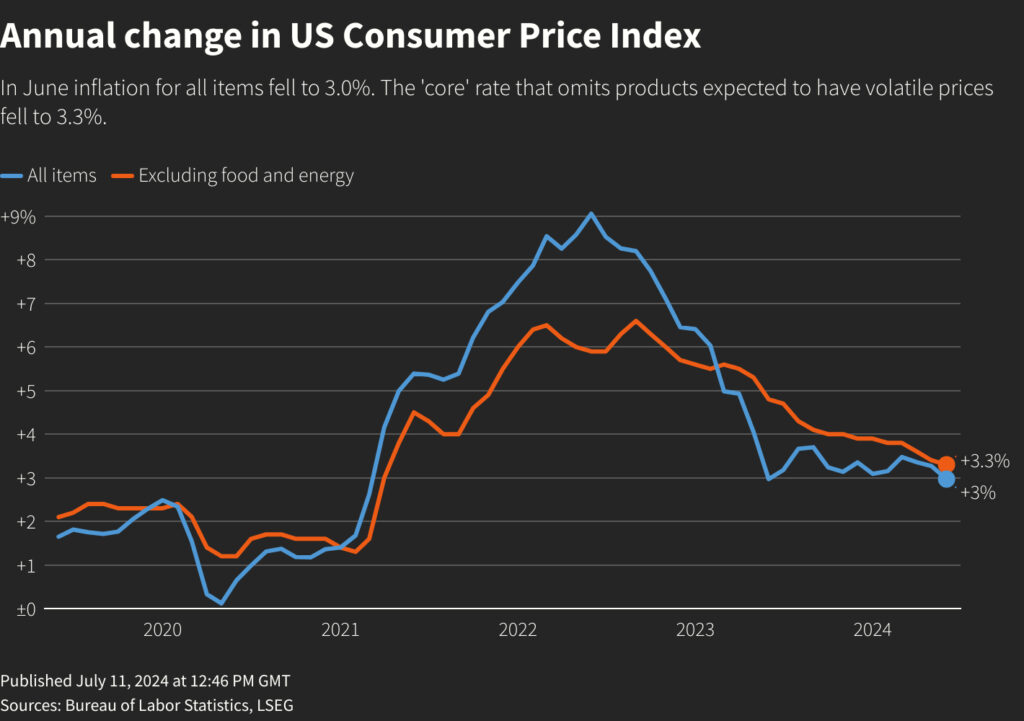Consumer Price Index (CPI) Drops for the First Time in Four Years
YEREVAN (CoinChapter.com) — In June, the US consumer price index (CPI) fell by 0.1%, the first decline in four years. This change was due to cheaper gasoline and moderating rents. The decrease in the CPI signals a return to disinflation and brings the Federal Reserve closer to considering interest rate cuts in September.
The Labor Department reported this data on Thursday, showing a second month of moderate consumer price readings. This trend is likely to boost confidence among Federal Reserve officials that inflation is cooling after a sharp surge in the first quarter.

Brian Bethune, an economics professor at Boston College, said,
“Barring rogue price data in July, the Fed has a checkered flag to reduce rates in September.”
Gasoline Prices Drop, Shelter and Food Costs See Mixed Changes in June CPI
The drop in the CPI was influenced by a 3.8% decrease in gasoline prices, following a 3.6% decline in May. Shelter costs, including rents, increased by 0.2% after a 0.4% rise in May. These figures highlight the impact of housing and energy costs on overall inflation rates.
Food prices rose by 0.2%, with grocery store prices ticking up by 0.1%. Dairy products, meat, fish, and eggs saw price increases, while fruits, vegetables, and cereals declined.
Yearly Inflation Rate and Core CPI Insights
Year-on-year, the CPI rose by 3.0%, the smallest gain since June 2023. This follows a 3.3% increase in May. Economists had predicted the CPI to rise by 0.1% month-on-month and 3.1% year-on-year, according to a Reuters poll.
The core CPI, excluding volatile food and energy prices, rose by 0.1% in June, the smallest monthly increase since August 2021. This was down from a 0.2% rise in May. The core CPI’s year-on-year increase was 3.3%, the smallest since April 2021, after a 3.4% rise in May.
Impact on Job Market and Financial Markets
The Labor Department also reported a decline in weekly jobless claims, which fell by 17,000 to 222,000 for the week ending July 6. This was the lowest level since late May. Continuing claims, which indicate the number of people receiving benefits after an initial week of aid, decreased by 4,000 to 1.852 million.

Financial markets responded with mixed reactions. Stocks on Wall Street were varied, US Treasury yields fell, and the dollar slipped against a basket of currencies. The data indicates a broad moderation in inflation, with some sectors showing more significant changes than others.
Fed’s Response and Market Predictions
Federal Reserve Chair Jerome Powell acknowledged the positive trend in inflation but emphasized the need for more good data before declaring victory over inflation. He mentioned that “more good data” would strengthen the case for rate cuts.
Financial markets are now betting on a high probability of the Fed starting its easing cycle in September. Market analysts see about an 85% chance of a rate cut at the Fed’s September meeting, up from 70% before the report. Two rate cuts are anticipated this year.
Additional Insights into Price Changes
The report showed some relief in healthcare costs, which rose by 0.2% after a 0.5% increase in May. Airline fares, used cars and trucks, new motor vehicles, and communication services also saw price decreases. However, motor vehicle insurance prices rebounded by 0.9% after falling 0.1% in May.
Household furnishings, personal care, education, recreation, and apparel costs rose, adding to the mixed inflation picture. The moderation in the CPI data is expected to reflect in the Personal Consumption Expenditures (PCE) price indexes, the inflation measures tracked by the central bank for monetary policy.

Estimates for June core PCE inflation ranged from 0.13% to 0.19%, with the core PCE price index edging up 0.1% in May. Core inflation was seen increasing by 2.5% year-on-year in June, following a 2.6% rise in May. These forecasts may adjust following June’s producer price report on Friday.
Christopher Rupkey, chief economist at FWDBONDS, said,
“There is light at the end of the tunnel finally after the central bank’s long battle with inflation and interest rate cuts, lots of them, are on the way.”
The post Consumer Price Index (CPI) Drops for the First Time in Four Years appeared first on CoinChapter.




